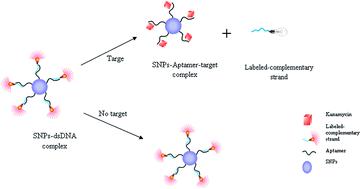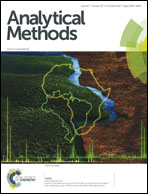Detection of kanamycin by using an aptamer-based biosensor using silica nanoparticles
Abstract
A fluorescent aptasensor system has been designed for the sensitive detection of kanamycin based on silica nanoparticles (SNPs) coated with streptavidin. The kanamycin aptamer, which served as the molecular recognition probe, was immobilized on the surface of the SNPs. In the absence of kanamycin, the SNPdouble stranded DNA (dsDNA) complex is intact and has the maximum fluorescent signal. Upon addition of kanamycin, the aptamer binds to its target and causes the dissociation of the labeled-complementary strand from dsDNA and SNPs, leading to a decrease of the fluorescence intensity. This aptasensor exhibited a high sensitivity toward kanamycin with a limit of detection (LOD) as low as 612 pM. The designed aptasensor was successfully used to detect kanamycin in serum and a limit of detection as low as 453 pM was obtained. By changing the related aptamer strand and its complementary strand, it could be expected that the proposed method offers a general sensing platform for the recognition of trace amounts of different drugs and biomolecules.


 Please wait while we load your content...
Please wait while we load your content...